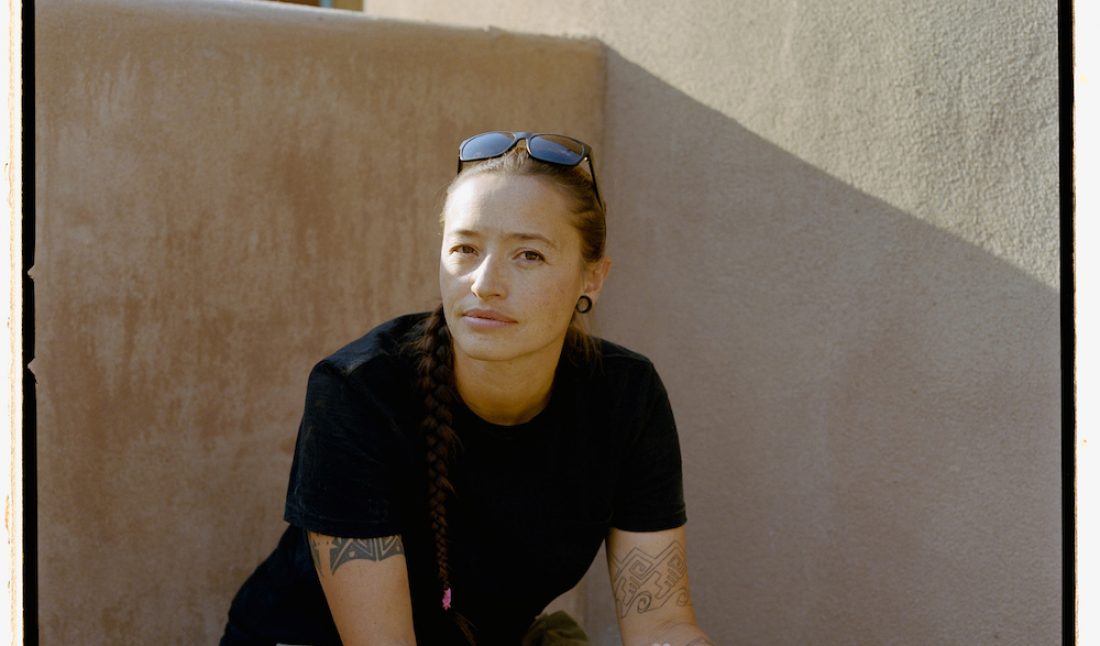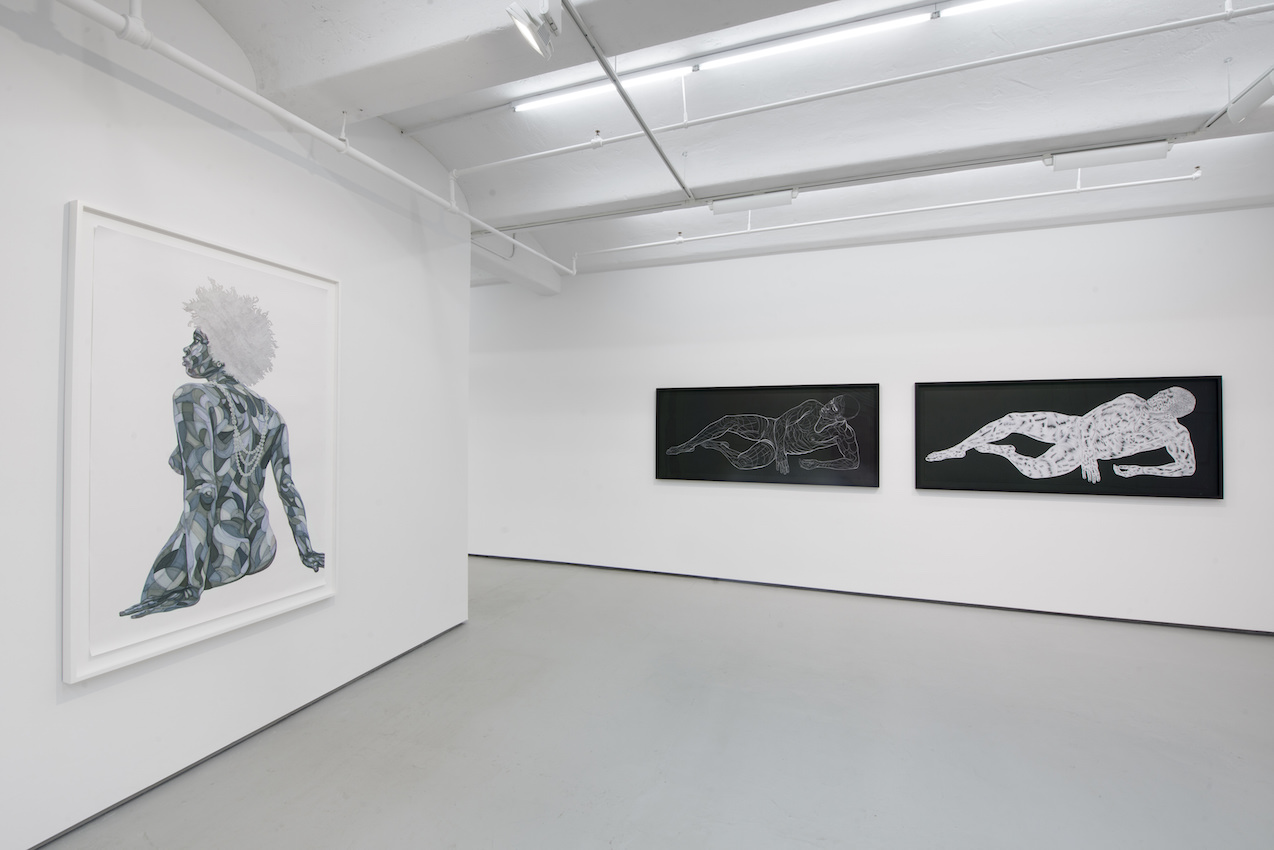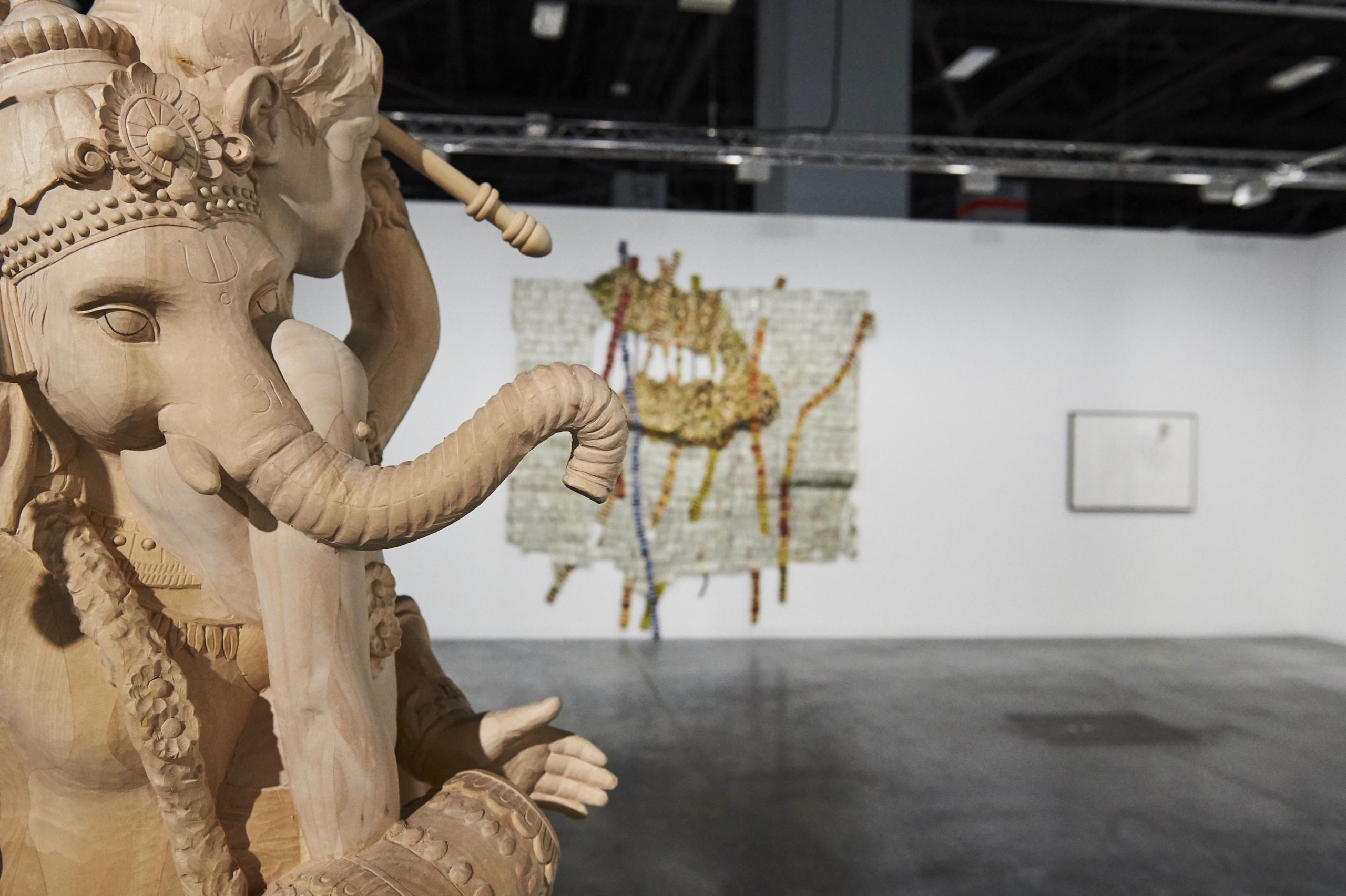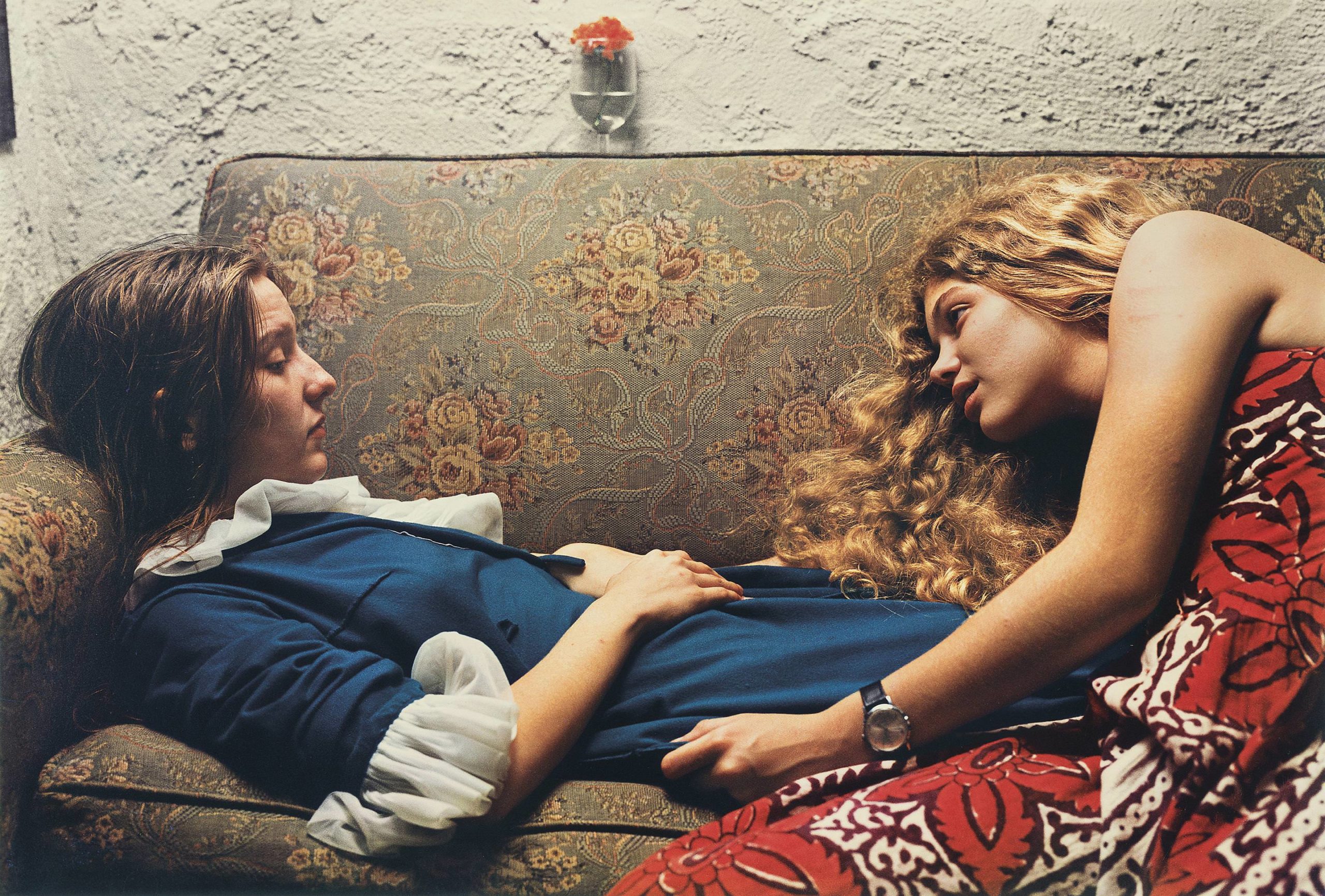Rose B. Simpson’s “Dream House” is currently on view at The Fabric Workshop and Museum (FWM) in Philadelphia through May 7. The immersive installation is the result of an artist-in-residence program with the museum, showcasing some of the earliest examples of Simpson’s explorations into collaboration, and what she describes as her most personal show yet.
Taking over the eighth floor of the space, it opens with a vast room against which visitors cast long shadows. They are greeted with the sight and smell of a traditional adobe wall, created onsite and inspired by the Pueblo architecture of Simpson’s ancestral land of Santa Clara Pueblo, New Mexico. As they enter, a series of rooms follows, which can only be viewed from a window, offering a glance at Simpson’s inner world but never a full picture. Secondary spaces are hinted at with sounds and video (the artist’s first time working in the medium), making the viewer lean in deeper to get a better look.
Working with the team of artisans at FWM, Simpson imagined interior spaces representative of her inner and outer worlds, creating furniture, textiles, lighting, tabletop pieces, a quilt, a rug, and even films—many for the first time. She is known for her figurative sculptures in clay that touch upon ancestral knowledge, generational healing, and spiritual realms, and “Dream House” is a revelatory, ambitious project, one that invites viewers to self-reflect, a challenge Simpson took on in the making of it.
Whitewall met with Simpson in Philadelphia just before the opening of “Dream House,” and we discussed getting passed the idea of needing her hand in everything, and opening up to the prospect of collaborating with others while still making super personal work. With her solo show “Road Less Traveled” at Jack Shainman opening this week (and up through April 8) and the public work “Countercultures” standing in Field Farm in Williamstown, Massachusetts, until April 30, Simpson’s sculptures are staring back, daring us to be present, vulnerable, and open to growth.
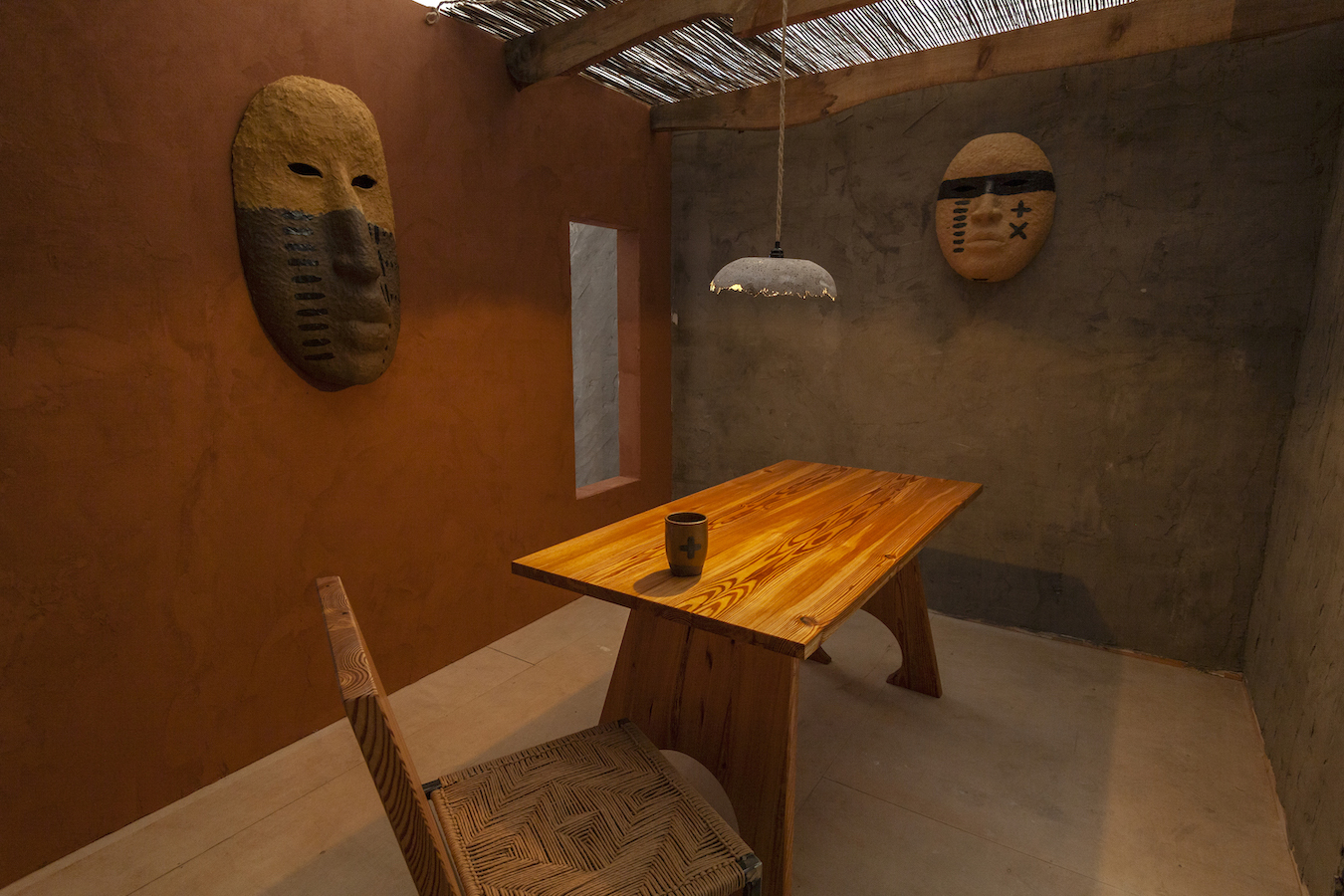 Installation view of Rose B. Simpson’s “Dream House,” photo by Carlos Avendaño, courtesy of the artist and The Fabric Workshop and
Museum.
Installation view of Rose B. Simpson’s “Dream House,” photo by Carlos Avendaño, courtesy of the artist and The Fabric Workshop and
Museum.
WHITEWALL: Where did you begin with this project and the residency at The Fabric Workshop?
ROSE B. SIMPSON: This residency started during the pandemic, so the first year almost was me and Karen Patterson [FWM’s former director of exhibitions] texting vigorously. She would ask me things like, “What are out thinking about today? What’s exciting you? What are you needing in your life and not getting?” I would send her photos of things I found beautiful in my day, podcasts, things I was thinking about. It was kind of like therapy. It was magical. It really was.
Initially, I was thinking about The Fabric Workshop to highlight my car stuff, because I really enjoy cars and working on cars. It’s been strange to find outlets for that in the world. They sent me the building restrictions and you really can’t put a car in there. So Karen was like, “What does a car mean to you? Why cars?” And we started digging.
Art is about creating your dream. It is intentionality manifest. What we’re doing and putting out there in the world is what we visualize and want to see. I live on the res in Santa Clara Pueblo, and we live in a little house my great-grandpa built for my great-grandma. Thinking about relational aesthetics and the very reason to do art, to apply arts to everything that we do, that’s where the cars come from. It’s about, how do you build an empowered experience? So Karen asked, “Where is that lacking in your life?” And I was like, “My home, my house.”
And then thinking about dreams and how the home itself is actually a metaphor for your body, your psychological states, the different rooms and places you enter within yourself. So how do you project out into your lived existence an experience of that?
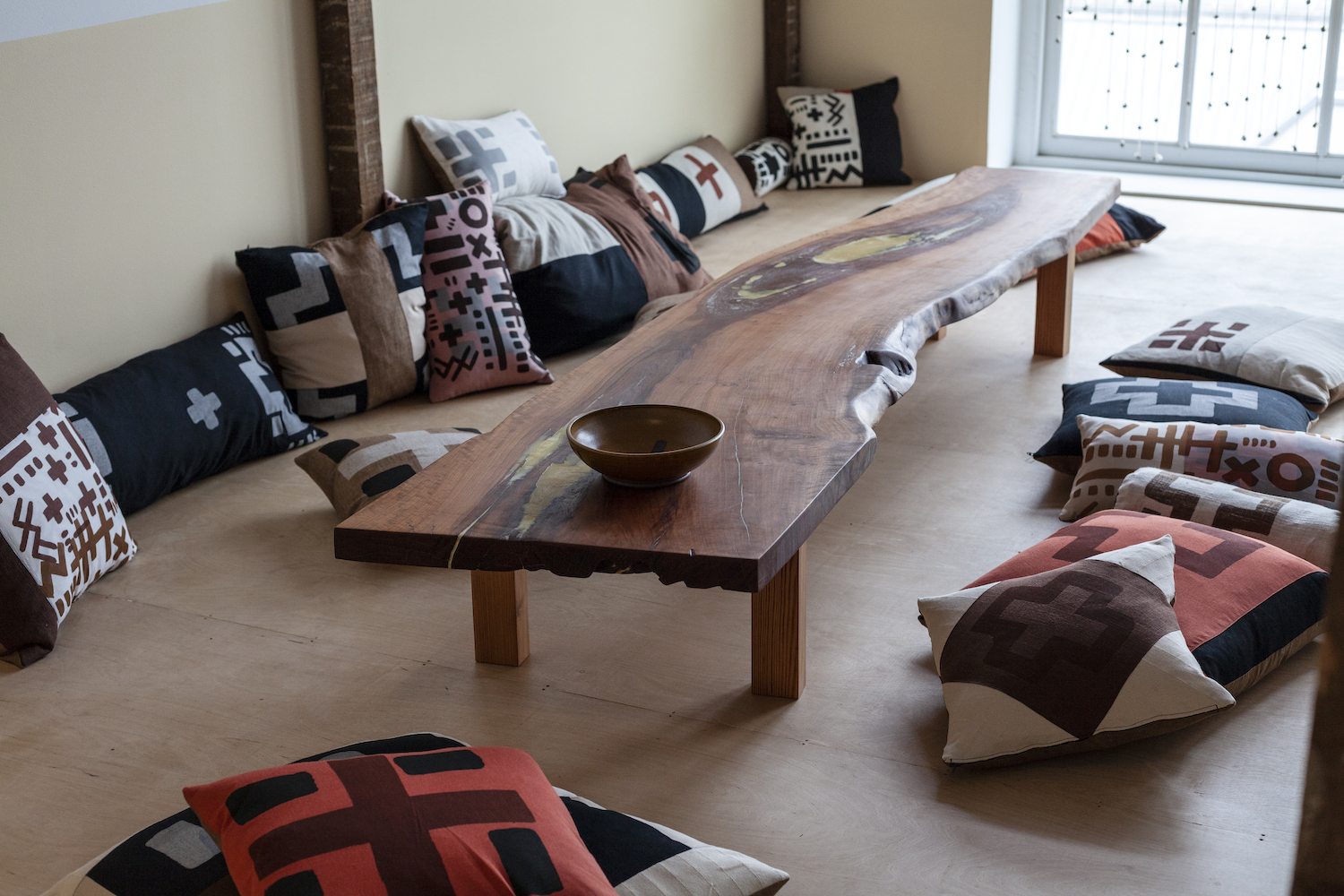 Installation view of Rose B. Simpson’s “Dream House,” photo by Carlos Avendaño, courtesy of the artist and The Fabric Workshop and
Museum.
Installation view of Rose B. Simpson’s “Dream House,” photo by Carlos Avendaño, courtesy of the artist and The Fabric Workshop and
Museum.
WW: So how were you thinking of a dream house? A phrase that can be totally on the surface and superficial.
RBS: Right! Is it manifesting what you want to be in, or is it showing those internal spaces? What we surround ourselves with is a reflection of what’s going on inside. Intentionally, there was this idea that there’s access, too. It’s like, this is my body, this is my psychological state, this is my prayer, this is my past, this is my future, and who is allowed in there. And there’s this idea of voyeurism in a very deep way. That’s what art is in so many ways—this window into part of our very intimate beings. My work is very much that.
So much of my work is looking back at the viewer, and this work is very internal. Each room has a subconscious room. There’s a room from the windows, and windows from that room where you’re able to see into a subconscious space.
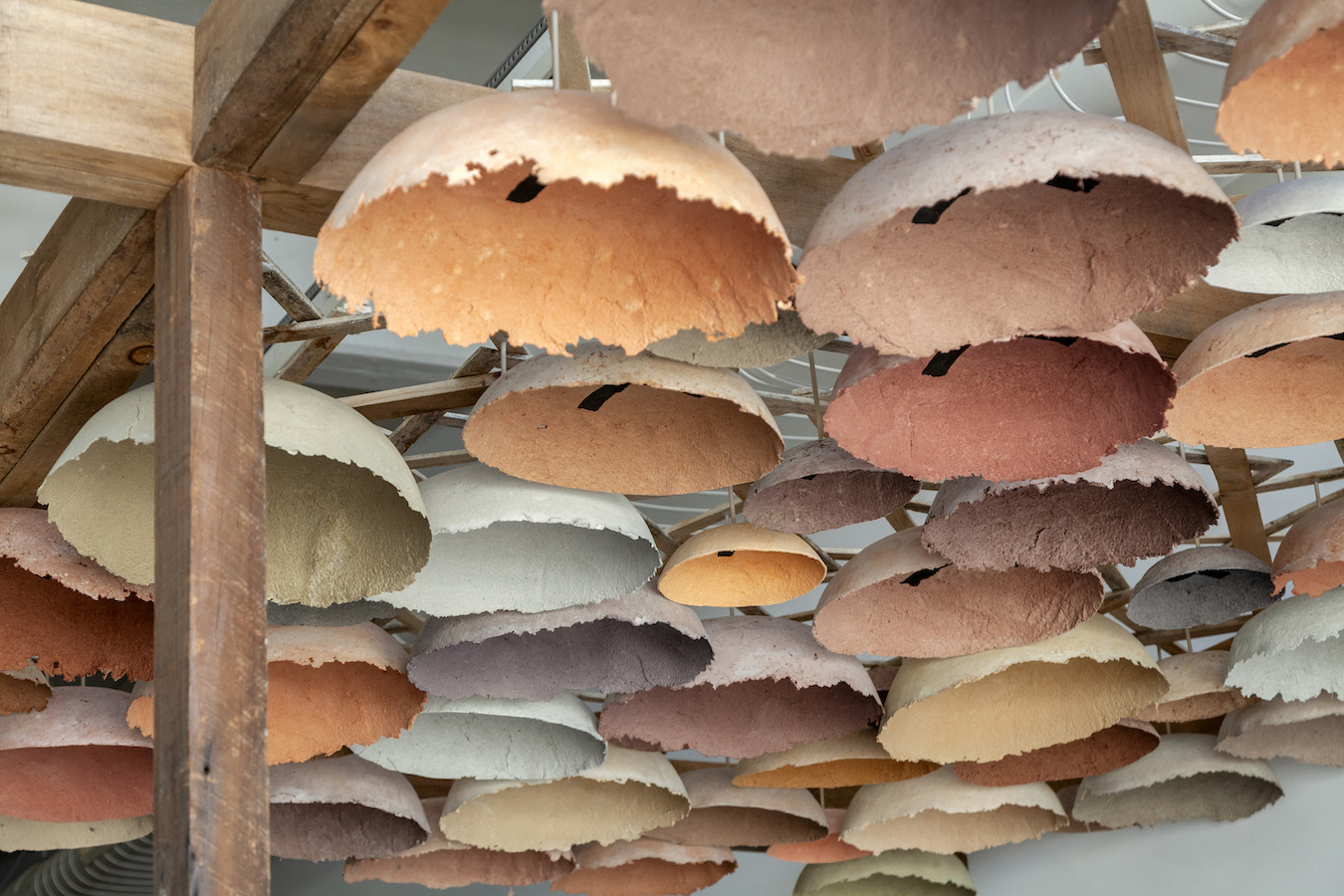 Installation view of Rose B. Simpson’s “Dream House,” photo by Carlos Avendaño, courtesy of the artist and The Fabric Workshop and
Museum.
Installation view of Rose B. Simpson’s “Dream House,” photo by Carlos Avendaño, courtesy of the artist and The Fabric Workshop and
Museum.
WW: Can viewers enter there?
RBS: No, you can barely see it. I kept wondering, how do you portray the deeper subconscious spaces? There’s access, there’s restriction, there’s boundaries, and then there’s welcoming. There are spaces you can’t enter but you can look in. And then there is the last space, where you are welcome to enter with respect; you can take your shoes off and you can come sit within it.
Through the show, we’re navigating these internal spaces, these dreamlike feeling spaces, and the last room is about being in the space with each other, doing that work of being aware. It’s under a very large window to be conscious of the environment, conscious of the weather, conscious of the sunlight, the moonlight.
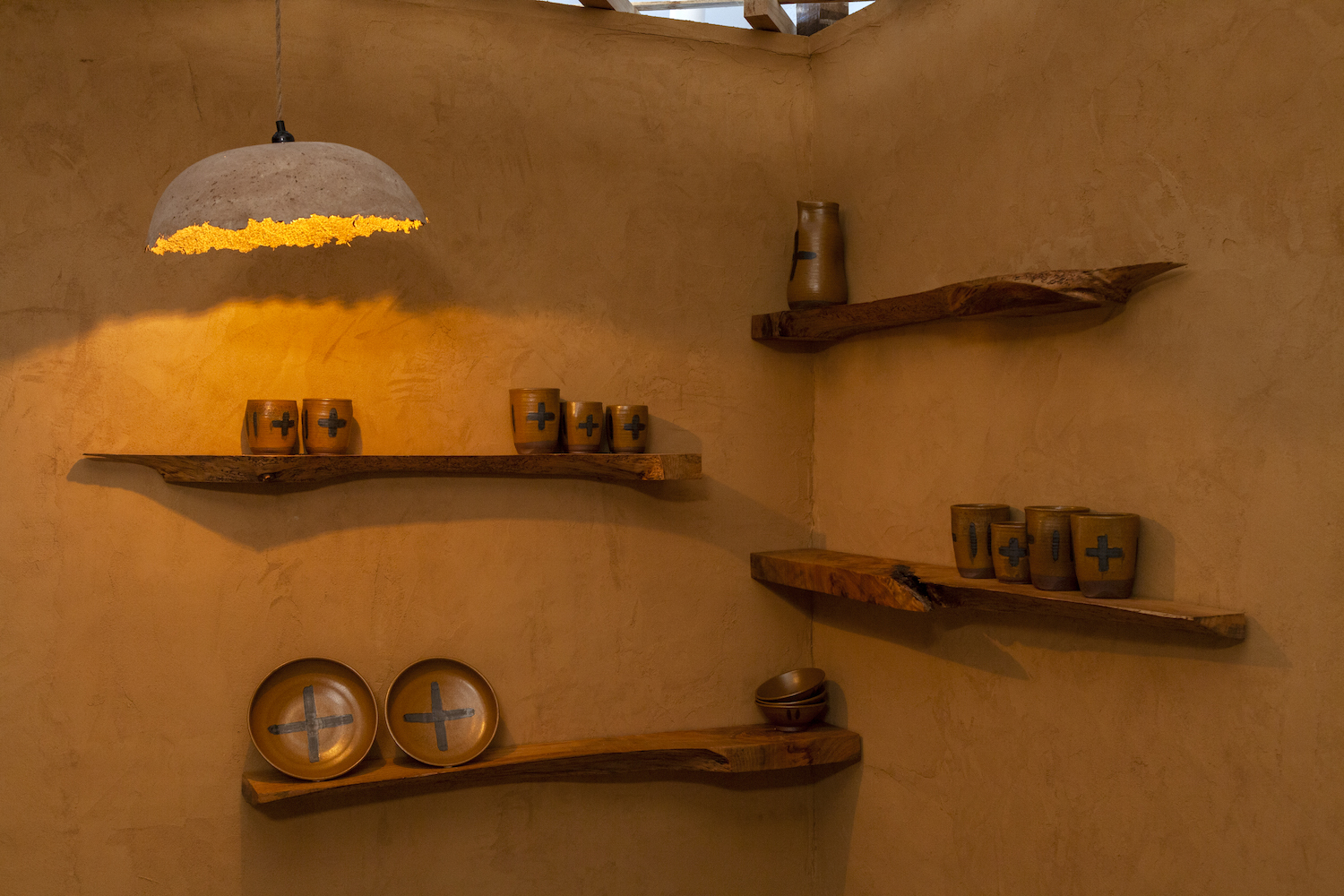 Installation view of Rose B. Simpson’s “Dream House,” photo by Carlos Avendaño, courtesy of the artist and The Fabric Workshop and
Museum.
Installation view of Rose B. Simpson’s “Dream House,” photo by Carlos Avendaño, courtesy of the artist and The Fabric Workshop and
Museum.
WW: You worked in new ways for this show, like with film. What was that like?
RBS: This is the first time I ever worked with film. The Fabric Workshop provided me with a camera and taught me how to use it. Me and technology don’t get along very well, so I did my best. We made a quilt, we sewed a rug, we made something like 25 pillows, we sourced natural wood and made furniture and shelving. It was basically finding delicious things and pulling them in to meet that. It hearkens back to the art versus craft and utility being an aesthetic of manner. It brings us back into the aesthetics of function and how we move through the world.
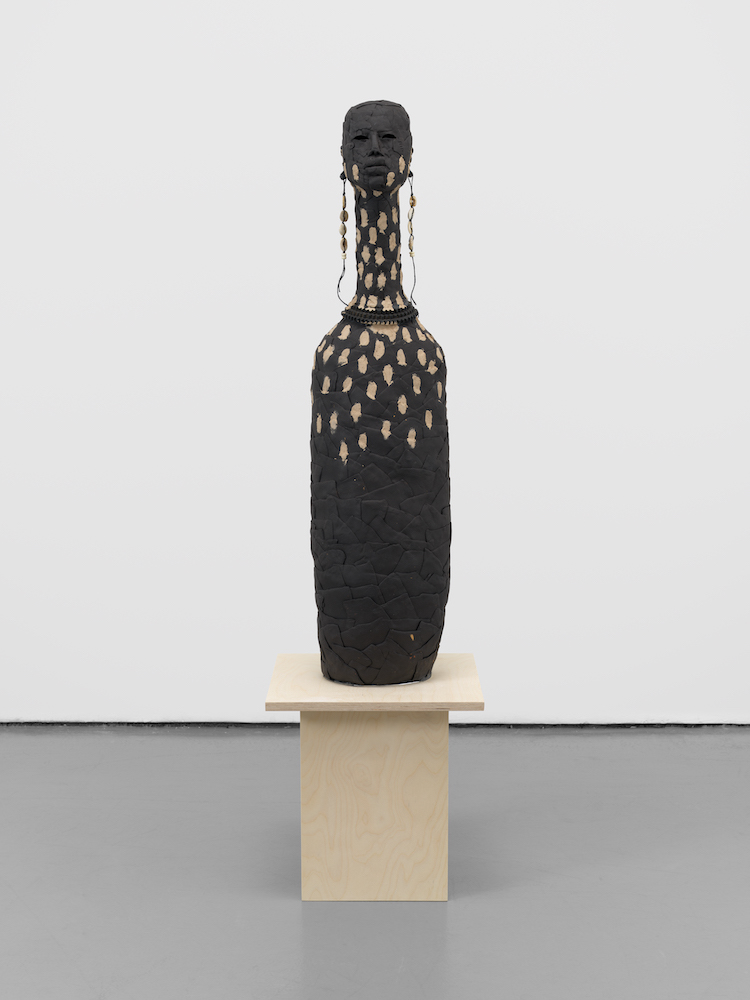 Rose B. Simpson, “Conjure III,” 2022, clay, timing belt, shell, twine, grout, 44 x 11 x 11 inches, © Rose B. Simpson. Courtesy of the artist, Jack Shainman Gallery, New York and Jessica Silverman, San Francisco.
Rose B. Simpson, “Conjure III,” 2022, clay, timing belt, shell, twine, grout, 44 x 11 x 11 inches, © Rose B. Simpson. Courtesy of the artist, Jack Shainman Gallery, New York and Jessica Silverman, San Francisco.
WW: Were there any new materials you found yourself enjoying working with? Anything about this process you want to continue with?
RBS: I think the biggest part of it, the biggest lesson in my life recently, has been collaboration. That is a tool that I’ve struggled with because my work is so intimate, it’s so personal and vulnerable. I feel like my hand needs to be it—that’s it. This is mine, I’ll be responsible for that. I’m not pulling anyone else into this.
But starting with the “Counterculture” pieces that are on view at the Field Farm in Williamstown, I had to figure out how to complete this vulnerable work and rely on other people. That was the first time I’ve ever outsourced any kind of labor on my work. So I made these three wooden originals; I sculpted them with a chainsaw because it was way easier to cast wood than clay. They are nine feet tall. We shipped them out and they cast them in concrete. Then I made beads for them, so that I had my hand in them.
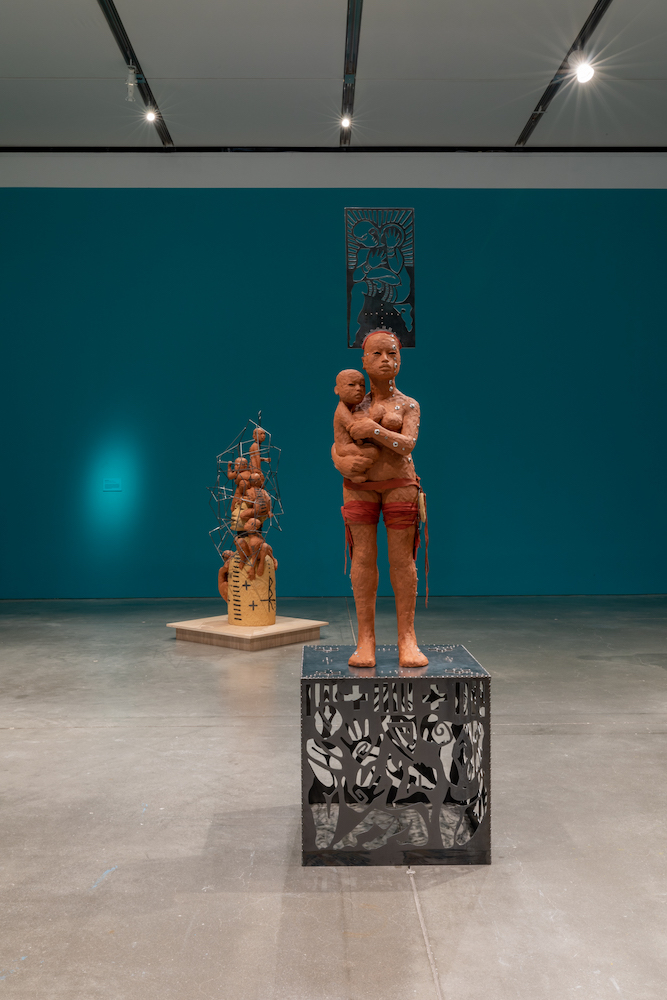 Installation view of Rose B. Simpson’s “Legacies,” photo by Mel Taing, courtesy of the artist and the Institute of Contemporary Art/Boston.
Installation view of Rose B. Simpson’s “Legacies,” photo by Mel Taing, courtesy of the artist and the Institute of Contemporary Art/Boston.
WW: So what is collaboration like for you, given that it’s so new to your practice?
RBS: I’m learning how to have faith in that process and also, to say, “Okay, Rose, you don’t have to do absolutely everything.” I had to think about how I could do this, to have other people’s hand in it and it still feel true. To have such an incredible crew to work with at The Fabric Workshop was so wonderful. Abby Lutz is leading the project, and she’s just a magical unicorn person.
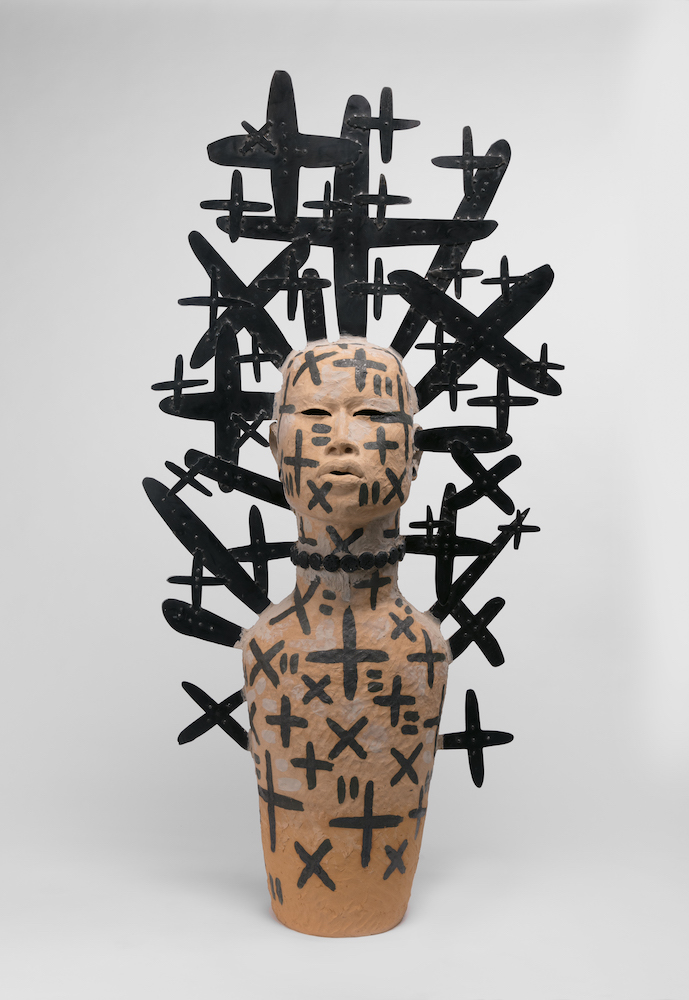 Rose B. Simpson, “Remind,” 2022, clay, steel, grout, lava beads, 66 x 35 x 15 inches, © Rose B. Simpson. Courtesy of the artist, Jack Shainman Gallery, New York and Jessica Silverman, San Francisco.
Rose B. Simpson, “Remind,” 2022, clay, steel, grout, lava beads, 66 x 35 x 15 inches, © Rose B. Simpson. Courtesy of the artist, Jack Shainman Gallery, New York and Jessica Silverman, San Francisco.
WW: That need to do it yourself, I wonder if it’s like that, too, when you’re working on cars?
RBS: Yeah. And I’m working on that one, too! Because I have a buddy who is working for me now with car stuff. And I’m like, oh wait, I get to do the fun part? The part I want to do? And then to redo the fuel system, something I’m not excited about, I can outsource that and there’s somebody out there that wants to do that?
When it comes to more of the aesthetic parts of it, I can come in it and, like, redo the dash the way I want to. I have a big sense of pride around that. I did it myself!
I have to pick and choose what I want to put my energy into. To trust other people with my vision is big. To collaborate, to delegate. I’m absolutely blown away by the amount of work everybody put in to make this come together. This is all very new for me.
WW: When you talk about working in clay, you talk about how the intention you put into the material shows up in the work. So it makes sense that you do feel the need to do it all, because it matters in the object you’re creating.
RBS: Right, and so I guess it’s a conversation around we’re all kind of in this together. And to be like, these people like doing this! They actually want to play with things I want to play with? So it’s new neural pathways to start with. When we went to Williamstown and I saw the pieces at the Field Farm for the first time, I had to pull over the car and get out and stand there and feel. My body was like, “Whoa, do I have space in my consciousness and my being for this kind of validation?” It’s really like, oh, I gotta grow. I gotta grow.
I stay busy to not feel the things, and when you finally just stop and it hits you, it’s like, wow. I’m also scared of what it means to grow into this truth, to let this happen for me. If you build it, you have to grow into it! If you manifest it, then you have to meet it. It’s a lot easier to stay simple than to bring in this relational complexity.
I think the biggest gift The Fabric Workshop gave me is community and trust and care and learning and believing in myself and the process.
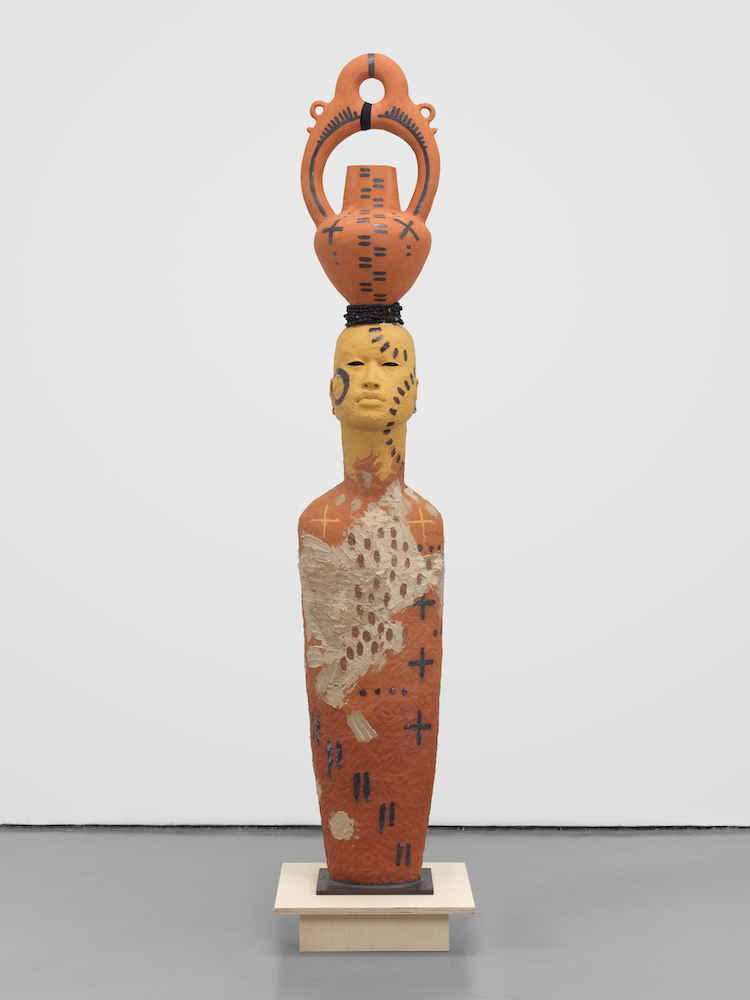 Rose B. Simpson, “Reclamation IV,” 2022, clay, steel, lava and bone beads, leather, grout
88 x 15 x 13 inches, © Rose B. Simpson. Courtesy of the artist, Jack Shainman Gallery, New York and Jessica Silverman, San Francisco.
Rose B. Simpson, “Reclamation IV,” 2022, clay, steel, lava and bone beads, leather, grout
88 x 15 x 13 inches, © Rose B. Simpson. Courtesy of the artist, Jack Shainman Gallery, New York and Jessica Silverman, San Francisco.






